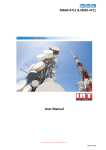Download MEM-4660 User Manual (Revision 03)
Transcript
MEM-4660 270Mb/ASI/SDI to Gigabit Ethernet Network Interface Adapter User Manual IRT Electronics Pty Ltd | www.irtelectronics.com Revision 03 MEM-4660 270Mb/ASI/SDI to Gigabit Ethernet Network Interface Adapter Revision History: Revision 00 Date 23/04/2010 By AL Original Issue. Change Description 01 20/04/2011 AL Equalisation specification updated to >250m. 02 06/11/2014 AL Extra output added to rear assembly. 03 13/11/2014 AL Extra output not applicable - removed. Applicable to: Firmware version ≥ MEM4660v1.0 Firmware version ≥ MEM4660v1.0 Firmware version ≥ MEM4660v1.0 Firmware version ≥ MEM4660v1.0 IRT Electronics Pty Ltd | www.irtelectronics.com Page 2 of 13 Revision 03 MEM-4660 USER MANUAL Table of Contents: Section Page Revision History Operational Safety General Description Technical Specifications Configuration Installation 270Mb/ASI/SDI Connections Ethernet Connection Alarm Output Connection Front and rear layouts Operation SNMP – What Is It? MEM-4660 SNMP Functions Maintenance & Storage Warranty & Service 2 3 4 5 6 7 7 7 7 8 9 10 12 13 13 This instruction book applies to firmware versions ≥ MEM4660v1.0. OPERATIONAL SAFETY WARNING Operation of electronic equipment involves the use of voltages and currents that may be dangerous to human life. Note that under certain conditions dangerous potentials may exist in some circuits when power controls are in the OFF position. Maintenance personnel should observe all safety regulations. Do not make any adjustments inside equipment with power ON unless proper precautions are observed. All internal adjustments should only be made by suitably qualified personnel. All operational adjustments are available externally without the need for removing covers or use of extender cards. IRT Electronics Pty Ltd | www.irtelectronics.com Page 3 of 13 Revision 03 MEM-4660 GENERAL DESCRIPTION BLOCK DIAGRAM MEM-4660 SIGNAL PATH MEM-4660 Signal 1 I/P (270Mb/ASI/SDI) Bidirectional Gigabit Ethernet 270Mb I/P 270Mb O/P Ethernet Signal 2 O/P (270Mb/ASI/SDI) MEM-4660 IP Signal 1 O/P (270Mb/ASI/SDI) Ethernet 270Mb O/P 270Mb I/P Signal 2 I/P (270Mb/ASI/SDI) SNMP SNMP The MEM-4660 acts as a gateway between a 270Mb/s ASI or SDI, and a Gigabit Ethernet network environment. The MEM-4660 is designed to operate as a pair with one unit at each end of the link. The unit can be set up to act as a transmitter or receiver for uni-directional operation, or as a transceiver (transmitter and receiver) for bi-directional operation. It is also possible to use multiple units at multiple locations to receive from a single transmitting unit. All parameters are set and read via a Simple Network Management Protocol (SNMP) system. As such the MEM-4660 must be operated, or at least set up, in one of IRT’s frames fitted with SNMP capability. Forward Error Correction (FEC) can be enabled or disabled on the transmitter with a 4/5 Length/Depth setting. The Gigabit Ethernet port has automatic MDI/MDI-X detection. This detects whether the Ethernet interconnect cable is a straight through or cross over type and automatically switches itself to accommodate. The MEM-4660 is designed to fit IRT’s current Eurocard 1RU and 3RU 4000 series frames fitted with SNMP control. Standard features: • • • • • • 270Mb/ASI/SDI to Gigabit Ethernet to 270Mb/ASI/SDI conversion Set up as either transmitter, receiver or both (transceiver) Supports enabling of Forward Error Correction (FEC) IP de-jittering RTP encapsulation, packet re-ordering SNMP setup and control IRT Electronics Pty Ltd | www.irtelectronics.com Page 4 of 13 Revision 03 MEM-4660 TECHNICAL SPECIFICATIONS Input: Type Impedance Return Loss Equalisation 1 x 270Mb/s, ASI or SDI, BNC connector. 75 Ohm. > 15 dB 5 MHz to 270 MHz. > 250 metres at 270 Mb/s for Belden 8281 or equivalent cable. Ethernet: Type Data Rate Connector Standard IEEE 802.3 1 Gb/s. RJ-45. Output: Type Signal level Impedance Return loss 1 x 270Mb/s, ASI or SDI (dependent on source unit), BNC connector. 800 mV ± 10%. 75 Ohm. > 15 dB 5 MHz to 270 MHz. Alarm: General Alarm Short to ground circuit on loss of Input (on transmitter), loss of RTP (on receiver), or link loss. Front Panel Indicators: 270Mb Link RTP Rx FEC Rx Alarm Power Requirements: Voltage Power consumption Other: Temperature range Mechanical Finish Dimensions Front panel Rear assembly 270Mb ASI or SDI connected – Green (Transmitter unit). LAN Activity – Green. RTP packets received – Green (Receiver unit). Forward Error Correction packets received – Green. General Alarm present – Red. 28 Vac CT (14-0-14) or ±16 Vdc. < 5 VA. 0 - 50° C ambient. Suitable for mounting in IRT 19" rack chassis with input, output and power connections on the rear panel. Grey background, black lettering & red IRT logo. Detachable silk-screened PCB with direct mount connectors to Eurocard and external signals. 6 HP x 3 U x 220 mm IRT Eurocard. Due to our policy of continuing development, these specifications are subject to change without notice. IRT Electronics Pty Ltd | www.irtelectronics.com Page 5 of 13 Revision 03 MEM-4660 CONFIGURATION Setup is via Simple Network Management Protocol (SNMP). MEM-4660 is required to be mounted in either IRT’s current 1RU or 3RU 4000 series frame fitted with SNMP capability. A Network Management System (NMS) software is also required to interface and set the MEM-4660 parameters. Some user knowledge of Internet Protocol (IP) addressing is assumed. SNMP Configuration Settings: irt4660ipRx enable (1) - Enables RTP Rx loss alarm on loss of RTP Rx input. Use this setting when operating unit in transceiver (both transmitter and receiver) or receiver only modes. noAlarms (2) - Disables RTP Rx loss alarm on loss of RTP Rx input. Use this setting when operating unit in transmitter only mode, else an alarm condition will be generated. Note that unit can still operate in receiver mode regardless of this setting. irt4660ipTx enable (1) - Enables MEM-4660 to act in both transmitter and transceiver modes. Off (2) - MEM-4660 acts as a receiver unit only. irt4660ipTxFec off (1) - No Forward Error Correction (FEC) added to transmitted signal. l4d5 (2) - Forward Error Correction (FEC) with Length 4 x Depth 5 added to transmitted signal. irt4660pingSink enable (1) - Enable MEM-4660 unit to ‘ping’ reciprocal MEM-4660 unit. off(2) - Ping Sink function turned off. irt4660localMac - Set local MAC address. This setting should already be pre-set and match that of sticker on the main board. The MAC address is a unique number given to this card and should not be changed so as to avoid possible conflicts with other existing MAC addresses. irt4660localIp - Set the IP address of this card. User settable. irt4660subnetMask - Set the Subnet Mask that this cards IP address will belong to. Default setting 255.255.255.000 irt4660gatewayIp - Set the Gateway IP address of the network that this card’s local IP address will be able to communicate through. irt4660remoteMAC - Set the remote MAC address of the MEM-4660 that this MEM-4660 will be sending to/receiving from. If sending to multiple locations a broadcast MAC address needs to be set. irt4660remoteIP - Set the remote IP address of the MEM-4660 that this MEM-4660 will be sending to/receiving from. If sending to multiple locations a broadcast IP address needs to be set. iIrt4660udpPort - Set UDP port number. UDP port number should be the same on both local and remote MEM-4660 cards. Default setting 1360. irt4660rxBufferSize - Set the receiver buffer size. Receiver buffer size should be the same on both local and remote MEM-4660 cards. Default setting 2047. irt4660Trap irt4660Reset Transmitter only set-up: irt4660ipRx noAlarms (2); irt4660ipTx enable (1). enable (1) - Enable Traps to be sent when an alarm (Input Tx Alarm, Input Rx Alarm, or Net Alarm) occurs and when it clears. disable (2) - No Traps will be sent when any alarm condition occurs or clears. - Unit reset control. A set with a value of 2 sent to this OID will cause a system reset to occur. When queried returns 1. After doing any IP or MAC addressing changes reset the card for settings to take affect. Receiver only set-up: irt4660ipRx enable (1); irt4660ipTx off (2). Transceiver set-up: irt4660ipRx enable (1); irt4660ipTx enable (1). NOTE: Besides these two settings (irt4660ipRx and irt4660ipTx), all other SNMP configuration settings also need to be set. IRT Electronics Pty Ltd | www.irtelectronics.com Page 6 of 13 Revision 03 MEM-4660 INSTALLATION Pre-installation: Handling: This equipment may contain or be connected to static sensitive devices and proper static free handling precautions should be observed. Where individual circuit cards are stored, they should be placed in antistatic bags. Proper antistatic procedures should be followed when inserting or removing cards from these bags. Power: AC mains supply: Ensure that operating voltage of unit and local supply voltage match and that correct rating fuse is installed for local supply. DC supply: Ensure that the correct polarity is observed and that DC supply voltage is maintained within the operating range specified. Earthing: The earth path is dependent on the type of frame selected. In every case particular care should be taken to ensure that the frame is connected to earth for safety reasons. See frame manual for details. Signal earth: For safety reasons a connection is made between signal earth and chassis earth. No attempt should be made to break this connection. Installation in frame or chassis: See details in separate manual for selected frame type. 270Mb/ASI/SDI Connections: Both the 270Mb/ASI/SDI input and output are 75 Ω BNC type for connection with high quality 75 Ω coaxial cable. Ethernet Connection: The Ethernet port on the rear assembly is for a standard non-crossover Ethernet cable fitted with an RJ-45 connector. This port connects directly to an Ethernet link, or via an Ethernet router or Ethernet switch. Alarm Output Connection: An opto-coupled alarm output via a 3 pole Phoenix style screw terminal block (PL6) on the rear connector assembly switches to ground circuit on loss of Input (on transmitter), loss of RTP (on receiver), or link loss. Pins 1 and 3 are grounds, pin 2 switches to ground when an alarm status has been raised. 1 GND 2 ALARM 3 GND PL6 IRT Electronics Pty Ltd | www.irtelectronics.com Page 7 of 13 Revision 03 MEM-4660 Front & rear panel connector diagrams: The following front panel and rear assembly drawings are not to scale and are intended to show connection order and approximate layout only. Gig-E Port Alarm O/P Not Used (if fitted) 270Mb/ ASI/SDI O/P 270Mb/ ASI/SDI I/P IRT Electronics Pty Ltd | www.irtelectronics.com Page 8 of 13 Revision 03 MEM-4660 OPERATION The MEM-4660 is designed to operate as a pair with a second MEM-4660. Each unit does the 270Mb/ASI/SDI to Ethernet (Gig-E) conversion and the reciprocal Ethernet to 270Mb/ASI/SDI conversion. It is intended to act as a 270Mb/ASI/SDI to Gigabit Ethernet then back to the original 270Mb/ASI/SDI conversions only. It will not perform Ethernet to 270Mb/ASI/SDI back to Ethernet conversions. Setup is done via SNMP as described in the Configuration and SNMP sections of this manual. Once the units have been set up correctly and connected to a Gig-Ethernet connection, a 270Mb type of signal, such as ASI or SDI, is inputted at one MEM-4660 and outputted at the other. Each MEM-4660 is able to act concurrently as an encoder and decoder allowing 270Mb type signals to flow both ways. Units can be set up to operate uni-directionally, that is as an encoder (transmitter) on one end and a decoder (receiver) at the other, or bi-directionally as both an encoder and decoder (transceiver) at both ends of the link. Front Panel LEDs give an indication of Ethernet and ASI settings, as described below: 270Mb RTP RX LINK FEC RX ALARM 270Mb Link RTP Rx FEC Rx Alarm 270Mb, ASI or SDI connected – Green (Transmitter unit) LAN Activity - Green RTP packets received – Green (Receiver unit) Forward Error Correction packets received – Green General Alarm present - Red IRT Electronics Pty Ltd | www.irtelectronics.com Page 9 of 13 Revision 03 MEM-4660 SNMP What Is It? SNMP stands for Simple Network Management Protocol. It is an application layer protocol for managing IP (Internet Protocol) based systems. SNMP enables system administrators to manage system performance, and to find and solve system problems. SNMP runs over UDP (User Datagram Protocol), which in turn runs over IP. Three types of SNMP exist: SNMP version 1 (SNMPv1), SNMP version 2 (SNMPv2) and SNMP version 3 (SNMPv3). It is not the intention here to discuss the differences between various versions, only to bring attention to the fact that IRT Electronics modules, fitted with SNMP capability, use SNMPv1. An SNMP managed network consists of three key components: Network Management Systems (NMS), agents, and managed devices. An NMS is the console through which the network administrator performs network management functions, such as monitoring status (e.g. alarm states) and remote controlling, of a set of managed devices. One or more NMS’s must exist on any managed network. Generally the NMS is a computer running third party SNMP control software. There are a number of third party SNMP software applications currently available on the market. An NMS polls, or communicates with, an agent. An agent is a network management software module that resides in a managed device. An agent has local knowledge of management information and translates that information into a form compatible with SNMP. The agent, therefore, acts as an interface between the NMS and the managed devices. The NMS sends a request message, and control commands for the managed devices, to the agent, which in turn sends a response message, containing information about the managed devices, back to the NMS. A managed device contains an SNMP agent and resides on a managed network. Managed devices collect and store management information and make this information available to NMS’s using SNMP. Managed device agent variables are organised in a tree structure known as a Management Information Base (MIB). Within the MIB are parameters pertaining to the managed device. An Object Identifier (OID) number within the MIB defines the managed device type. This is a unique number specific to the model of managed device. Other information relating to the device is also stored, information such as alarm states, controllable settings, etc. The MIB tree is organised in such a way that there will be no two MIB files with conflicting placements. Normally an NMS polls an agent for information relating to the MIB in a managed device to be sent back to the NMS. When certain conditions are met within the MIB, such as major alarm conditions, for example, the agent automatically sends what is known as a trap to the NMS without any prompting from the NMS. This allows automatic notification of a predetermined event. SNMP Block Diagram NMS IP Network NMS SNMP Agent Protocol Engine MIB SNMP Agent SNMP Agent Protocol Engine MIB SNMP Agent SNMP Agent Protocol Engine MIB SNMP Agent IRT Electronics Pty Ltd | www.irtelectronics.com Page 10 of 13 Revision 03 MEM-4660 SNMP with IRT Products: IRT Electronics currently employs SNMPv1 with its SNMP capable frames. The frame acts as an agent when fitted with a CDM-xxxx module. This module has its own designated slot next to the power supply so as to not affect the number of modules that the frame will take. Communication between the NMS, the frame and its loaded modules are via this CDM-xxxx module. Note that the NMS software is third party and not supplied by IRT Electronics. Ethernet connection for SNMP operation is via an RJ45 connector on the rear of the frame, below the mains inlet. Ethernet rate runs at either 10 baseT or 100 baseT. Frame parameters, such as Name, Address and Location, are set via an RS232 interface, a D9 connector on the rear of the frame below the mains inlet. A software terminal emulator, such as Tera Term or HyperTerminal, is used for setting and reading the parameters of the frame. IRT modules that are SNMP compatible may need an optional plug-in SNMP module with a program relevant to the module that it is plugged into. Depending on the module, besides the module identification, parameters such as alarm states, inputs and controls etc. are communicated to the CDM-xxxx agent via a data bus on the rear of the frame. Thus the CDM-xxxx collects information on what is loaded within the frame, what positions they occupy, and their current status for communication to the NMS when the NMS sends a request for information. In the event of a major alarm from any of the SNMP compatible modules, or power supplies, a trap is automatically sent by the CDM-xxxx agent to the NMS without any prompting by the NMS. This alerts the operator to any fault conditions that may exist that need immediate attention. 110/240 V 50/60 Hz 0.7 A (max.) FRU-4000 FRAME FUSES 220/240 Vac 500 mA S.B. 110/120 Vac 1A S.B. RS232 Alarm Ethernet + 48Vdc AS3260 approval no.: CS6346N Ass. no.: 804692 IRT SNMP Connections NMS Ethernet Cable IP Network IRT modules fitted with SMU-4000 CDM-xxxx PSU’s IRT SNMP Frame Ethernet Cable IRT modules fitted with SMU-4000 CDM-xxxx PSU’s IRT SNMP Frame Ethernet Cable IRT SNMP Setup IRT Electronics Pty Ltd | www.irtelectronics.com Page 11 of 13 Revision 03 MEM-4660 MEM-4660 SNMP Functions: With the MEM-4660 installed in an IRT 4000 series frame with SNMP capability, the MEM-4660 can be configured and interrogated by an SNMP Network Management System (NMS). The following SNMP functions are capable of being configured and monitored by an NMS: Alarm States: - An indication of the current state of the transmitter (Tx) input alarm [noAlarm (1), inputLoss (2)]; irt4660ipRxAlarm - An indication of the current state of the receiver (Rx) input alarm [noAlarm (1), rtpRxLoss (2)]; irt4660enetAlarm - An indication of the current state of the Ethernet alarm [noAlarm (1), linkLoss (2)]; irt4660ipTxAlarm Status: irt4660InputPresent irt4660EthernetLink irt4660rtpRx irt4660fecRx irt4660fecRxD irt4660fecRxL - An indication that the 270Mb/s input signal is present [notPresent (1), present (2)]; An indication that an Ethernet link has been established [inactive (1), active (2)]; An indication that RTP packets have been received [notPresent (1), present (2)]; An indication that Forward Error Correction (FEC) packets have been received [notPresent (1), present (2); An indication of FEC depth received RxD [0 if FEC notPresent, 5 if FEC present]; An indication of FEC length received RxL [0 if FEC notPresent, 4 if FEC present]; Configuration: 1 - Set and read whether MMM-4660 can issue a RTP Rx loss alarm on loss of RTP input [enable (1), noAlarms (2)]; irt4660ipTx - Set and read whether MMM-4660 is set up in transmitter mode [enable (1), off (2)]; 2 irt4660ipTxFec - Set and read whether FEC is enabled for use when in transmitter mode [off (1), l4d5 (2)]; 3 irt4660pingSink - Set and read whether MMM-4660 is set up with Ping Sink setting enabled [enable (1), off (2)]; irt4660localMac - Set and read the local MAC address of the local MEM-4660. This address has already been preset and matches that of a sticker on the card. irt4660localIp - Set and read the local IP address of the local MEM-4660. irt4660subnetMask - Set and read the sub-net mask address. irt4660gatewayIp - Set and read the gateway IP address. irt4660remoteMac - Set the remote MAC address of the second (remote) MEM-4660. irt4660remoteIp - Set the remote IP address of the second (remote) MEM-4660. irt4660udpPort - Set and read the UDP port number. Both this MEM-4660 and the second (remote) MEM-4660 should be set the same. irt4660rxBufferSize - Set and read the receiver buffer size. Both this MEM-4660 and the second (remote) MEM-4660 should be set the same. irt4660Trap - Trap automatically sent, if enabled, when an alarm (Input Tx Alarm, Input Rx Alarm, or Net Alarm) occurs and when it clears [enabled (1), disabled (2)] irt4660Reset - Unit reset control. A set with a value of 2 sent to this OID will cause a system reset to occur. When queried returns 1. irt4660ipRx Firmware Version: irt4660FpgaVersion - The software version of the main FPGA in the format ‘x.y’, where x is the major rev. no. and y the minor. NOTE: 1 If using as a transmitter only, set this setting to noAlarm (2) so that RTP Rx alarm is disabled. Enabling this setting allows alarm to operate on loss of RTP received detection. Note that MEM-4660 still operates in receiver mode regardless of this setting. 2 Only one Forward Error Correction (FEC) setting available (4 packets long x 5 packets deep (l4d5)). 3 Ping Sink is defined as the MMM-4660 acting as a transmitter communicating (pinging) with the receiver module to establish that a path has been established. IRT Electronics Pty Ltd | www.irtelectronics.com Page 12 of 13 Revision 03 MEM-4660 MAINTENANCE & STORAGE Maintenance: No regular maintenance is required. Care however should be taken to ensure that all connectors are kept clean and free from contamination of any kind. This is especially important in fibre optic equipment where cleanliness of optical connections is critical to performance. Storage: If the equipment is not to be used for an extended period, it is recommended the whole unit be placed in a sealed plastic bag to prevent dust contamination. In areas of high humidity a suitably sized bag of silica gel should be included to deter corrosion. Where individual circuit cards are stored, they should be placed in antistatic bags. Proper antistatic procedures should be followed when inserting or removing cards from these bags. WARRANTY & SERVICE Equipment is covered by a limited warranty period of three years from date of first delivery unless contrary conditions apply under a particular contract of supply. For situations when “No Fault Found” for repairs, a minimum charge of 1 hour’s labour, at IRT’s current labour charge rate, will apply, whether the equipment is within the warranty period or not. Equipment warranty is limited to faults attributable to defects in original design or manufacture. Warranty on components shall be extended by IRT only to the extent obtainable from the component supplier. Equipment return: Before arranging service, ensure that the fault is in the unit to be serviced and not in associated equipment. If possible, confirm this by substitution. Before returning equipment contact should be made with IRT or your local agent to determine whether the equipment can be serviced in the field or should be returned for repair. The equipment should be properly packed for return observing antistatic procedures. The following information should accompany the unit to be returned: 1. 2. 3. 4. 5. 6. 7. A fault report should be included indicating the nature of the fault The operating conditions under which the fault initially occurred. Any additional information, which may be of assistance in fault location and remedy. A contact name and telephone and fax numbers. Details of payment method for items not covered by warranty. Full return address. For situations when “No Fault Found” for repairs, a minimum charge of 1 hour’s labour will apply, whether the equipment is within the warranty period or not. Contact IRT for current hourly rate. Please note that all freight charges are the responsibility of the customer. The equipment should be returned to the agent who originally supplied the equipment or, where this is not possible, to IRT directly. Details of IRT’s direct address can be found at IRT Electronics’ website. Web address: www.irtelectronics.com Email: [email protected] IRT Electronics Pty Ltd | www.irtelectronics.com Page 13 of 13 Revision 03
























